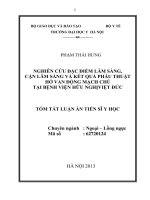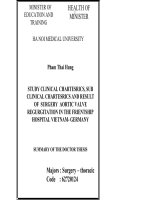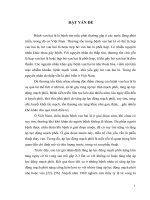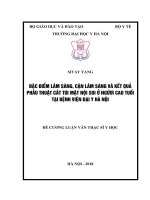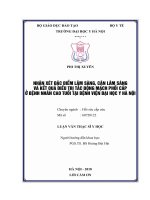Nghiên cứu đặc điểm lâm sàng, cận lâm sàng và kết quả phẫu thuật chỉnh trục xương chi dưới ở bệnh nhân tạo xương bất toàn tt tiếng anh
Bạn đang xem bản rút gọn của tài liệu. Xem và tải ngay bản đầy đủ của tài liệu tại đây (177.69 KB, 27 trang )
MINISTRY OF EDUCATION
MINISTRY OF DEFENSE
VIETNAM MILITARY MEDICAL UNIVERSITY
TRAN QUOC DOANH
STUDY OF CLINICAL, SUBCLINICAL FEATURES AND
CORRECTIVE SURGERY OUTCOMES OF LOWER LIMB
AXIS IN PATIENTS WITH OSTEOGENESIS IMPERFECTA
Specialization: Surgical
Code: 9720104
SUMMARY OF PHD. THESIS IN MEDICINET
HA NOI - 2020
This thesis was conducted at: Vietnam Military Medical University
Supervisors:
1. Assoc. Prof. Pham Dang Ninh, MD, PhD
2. Prof . Luong Dinh Lam
Peer-review 1: Assoc. Prof. Nguyen Manh Khanh
Peer-review 2: Prof . Nguyên Vinh Thong
Peer-review 3: Assoc. Prof. Vu Nhat Dinh
The thesis will be defensed at Council of Vietnam Military Medical
University
at …… …… …… 2020
The thesis can be found at these libraries:
National library
The library of Vietnam military medical academy
1
INTRODUCTION
Osteogenesis imperfecta (OI) is a congenital disorder of the bone.
The cause of the disease is a mutation in the type I collagen synthesis
gene that makes bones fragile and deformed.
In the world, there have been many researches on surgical treatments
with the aim of cutting the orthostatic bone structure and fixing
broken bones to improve quality of life, limiting fractures.
Vietnam has not had a comprehensive study of epidemiological
characteristics, clinical symptoms, subclinical and results of
treatment of OI. Medical treatment does not improve motor skills.
Therefore, the daily life problem of the patient still depends on the
family and the medical staff.
From the above reasons, we conduct research topic "Study of
clinical, subclinical features and corrective surgery outcomes of
lower limb axis in patients with Osteogenesis imperfecta" with the
following two objectives:
1. Surveying some clinical features and X-ray images of long bones,
skulls, spine, blood biochemical tests and electrolytes in patients with
Osteogenesis imperfecta.
2. Evaluation of internal bone results using self-made tool to treat
deformation of the lower limbs in patients with Osteogenesis
imperfecta at Military Hospital 7 A.
NEW CONTRIBUTIONS OF THE THESIS
1. Evaluate in detail clinical features, X-ray images of long bones,
flat bones, spine bones, biochemical tests of blood and electrolytes in
patients suffering from Osteogenesis imperfecta.
2
2. Research has created a self-supporting tool to support root canal
drilling after the bone is cut at the deformed position, which makes it
easier to perform surgery, resulting in improved bone resection and
alignment surgery time.
3. The first study in Vietnam with a sufficiently large number, details
of the research on treatment of lower limb deformation in patients
with Osteogenesis imperfecta disease using internal self-created kits.
This is a new feature compared to the method of Topouchian's author
and this is a method of combining bone with specific characteristics
of the disease to get good results. The results of the research are a
valuable contribution to the development of the Orthopaedics and
Trauma Surgery specialization and has a highly humanity.
THESIS STRUCTURE
The thesis consists of 126 pages, with 4 chapters: Introduction - 02
pages, Chapter 1: Litlerature review 30 pages, Chapter 2: Objectives
and research methods - 25 pages, Chapter 3: Results - 35 pages,
Chapter 4: Discussion - 30 pages, Conclusions - 02 pages and
Recommendations 01 page. The thesis has 49 tables, 34 figures, 7
images, 108 references including 4 Vietnamese documents and 104
English documents.
Chapter 1. LITLERATURE REVIEW
1.1. Osteogenesis imperfecta disease
1.1.1. Clinical characteristics and classification
1.1.1.1. Clinical:
Specific features are the long bones easy to fractures, blue scabs,
imperfect formation of teeth, hearing loss or loss.
1.1.1.2. Classification of Osteogenesis imperfecta disease
3
Sillence (1979) is classified into 4 types, based on clinical features,
X-ray features and family history.
1.2. Subclinical
1.2.1. Characteristics of bone deformation on X-ray film
1.2.1.1 Long bones
- Bone deformation is a common deformation.
- Images of cystic bone or calcified "popcorn" in onions, seen
in type III.
- Many bold images in the bones.
1.2.1.2. Spine
- Scoliosis of the lumbar spine
1.2.1.3. The skull
- Skull with few bones or multiple skulls
1.2.2. Biochemical characteristics of blood and electrolytes
1.2.2.1. Blood biochemical test
Complete blood count tests are within normal limits
1.2.2.2. Electrolytes
Concentrations of calcium ion, total serum calcium are within normal
limits.
1.3. Diagnose
1.5.1. Specific Diagnose
Based on clinical symptoms, X-ray images, history of fractures and
family history.
1.4. Treatment
1.4.1. In the world
+
Medical
treatment:
bisphosphonate.
Medical
treatment
with
intravenous
4
+ Surgical treatment: Topouchian V. et al (2006) used a pair of
cognitive equations for CXCT.
1.4.2. In Viet Nam
+ Medical treatment: Vietnam is using Rauch's treatment regimen
(2003).
+ Surgical treatment: Nguyen Ngoc Hung et al. (2016) reported on
the results of the surgery to fix the internal bone axis in the long
lower limb body in patients with OI equal to 1 intramedually nail for
24 patients with 29 femur undergoing surgery, the time after the bone
to heal. surgery from 12-18 weeks, 10 patients have the prospect of
walking, 10 patients have access to support equipment and 4 patients
still have to sit in a wheelchair, the average time of fractures, curved
nails, buds sticking out of the bone 17 months after surgery.
Chapter 2. RESEARCH SUBJECTS AND METHODS
2.1. Object, time, place of study
Including 42 patients with OI at Military Medical Hospital 7A Military Region 7, from January 2012 to December 2016.
2.1.1. Inclusion criteria
+ Patients diagnosed with OI based on clinical diagnosis criteria of
author Jin T.Y. et al (2016):
- Idiopathic and / or recurrent fractures
- Blue sclerae
- Dentinogenesis imperfecta
- Hearing loss reduced
Clinical diagnosis of OI when at least 2 of the 4 criteria above.
+ Patients and their families agree to participate in the study
+ Patient's medical record has all research criteria
5
2.1.2. Standard surgical treatment:
+ Patient could not walk due to limb deformation
+ Fractures many families require surgery
+ Brittle bones
+ Surgery age 2 years or older
2.1.3. Exclusion criteria
+ Do not have enough medical records and X-ray film archives
+ Patients do not agree to participate in the study (the family requires
no surgery)
+ Tests and clinical are not OI diseases
+ There are combined diseases not stable treatment
+ Skeletal deformation but patients can walk
2.2. Methodology
2.2.1. Study design
+ Step 1: Conducting research, cross-sectional description, without
control group based on a consistent research sample form from which
to reach the conclusion of goal 1.
+ Step 2: Select a group of patients with lower limb surgery to
conduct intervention and evaluate the results of surgical treatment to
address goal 2.
2.2.2. Sample size
Because this is a rare condition, in this study, we chose the
convenient sampling method, including all subjects that meet the
criteria for selection in the study subjects.
The target sample 1 is 42 patients, the target sample 2 is 33 patients
2.3. Research content
2.3.1. Target 1
2.3.1.1. Clinical research
6
+ Age, gender, family history, history of fractures, number of
fractures, frequency of fractures, location of fractures, location of
first fractures, previous treatment of fractures in lower limbs.
+ Functional symptoms: aching bones, dizziness, constipation, easy
bruising
+ Physical symptoms: Triangular face, blue eyes, strengthening
imperfections, hearing or hearing loss, chest, spine, clinical bone
deformities, preoperative movement: Self-sitting, crawl with your
butt, stand on your own, stand with support, walk on your own, walk
with support.
2.3.1.2. Research on subclinical
+ X-ray:
Skull bone: Investigate the presence of multiple skull bones
Long bones: Distorted deformity, calcification of popcorn, dark veins in
onions.
Spine bone: Scoliosis image, collapsed vertebra.
+ Blood chemistry: The concentration of Glucose, SGOT, SGPT,
Creatinine,
Urea compared to normal values.
+ Electrolyte: Blood calcium concentration: Ca ++, total calcium
compared to normal values.
2.3.2. Target 2
2.3.2.1. Internal osteosurgery uses self-made kits to treat deformities
of the lower limbs in imperfect bone formation
- Self-created kits for root canal drilling at cut bone section.
- Tools for driving through double nails.
- Tools for piercing heads on tibia.
- Homemade locking brace (point locking brace).
7
2.3.2.2. Result evaluation
+ Evaluate early results
- In surgery: Surgical time, blood loss, surgical site, surgical methods,
number of bone / bone section / cut, combined fracture bone tool,
root canal drilling, amount of transfusion blood, accidents, dialysis
accident management, reinforced with flour troughs, shaft alignment
results
- After surgery:
≤ 1 month after surgery: Evolution at the incision,
combined fracture bone techniques, complications
and management measures.
Postoperative assessment at follow-up visits: ≥ 1
month, ≥ 3
months, ≥ 6 months after surgery: Distortion of bone, movement,
bone axis (straight axis: Deformation angle <100, non-straight axis:
Deformation angle> 200). Instrument alignment: Nails located in the
canal, bent nails, broken nails, nails protruding from the shell bone or
nails into the joint socket, turn on the screw. Bad condition of 2 nails
on normal X-ray film. Fracture fracture, callus grade.
+ Evaluate far results
Time of re-examination: ≥ 12 months, ≥ 24 months, ≥ 36 months).
The evaluation criteria: deformation of bone, movement, axial axis,
instrument alignment, the condition of sliding 2 nails in case of using
double nails, broken bones, fractured positions. Evaluation of
surgical results based on the score sheet of El Sobky M. et al. The
index of life satisfaction after surgery is assessed on the basis of
Likert scale.
8
Chapter 3. RESEARCH RESULTS
3.1 Clinical features and X-ray image of long bones and bones skull,
spine, blood biochemical tests and electrolytes in patients with
Osteogenesis imperfecta.
3.1.1. Age and gender
Table 3.2. Age characteristics of
surgical patients group (n
= 33)
Sex
Males
Criteria
n
Rate
%
Females
n
Rate
Total
Rate %
%
From 2 to < 6
4
25,0
4
23,5
8
24,2
6 - < 10
2
12,5
5
29,4
7
21,2
10 - < 18
10
62,5
6
35,3
16
48,5
≥ 18
0
0,0
2
11,8
2
6,1
Total
16
100
17
100
33
100
The group of surgical patients is mainly in the developing age,
accounting for the most, from the age of 10 - <18.
3.2. The results of treating lower limb bone deformities in
Osteogenesis imperfeta disease using self-created kit
3.2.1. The early results
+ Postoperative results:
At the time of follow-up examination: ≥ 1, ≥ 3, ≥ 6 months after
surgery
9
Table
3.35. X-ray test results (n = 53, n: Number of
bones)
≥1
X-rays results
month
(n = 49)
Callus
Rate
%
≥3
months
(n = 47)
Rate
%
≥6
months Rate %
(n=45)
Grade 1
47
95,92
0
0
0
0
Grade 1
0
0
45
95,74
0
0
Grade 1
0
0
0
0
43
95,56
No callus
2
4,08
2
4,26
2
4,44
49
100
47
100
45
100
Total
After ≥ 1 month and ≥ 3 months, there are 2 cases of no calcification.
After ≥ 6 months, there are 2 cases non-union and re-operated
Table 3.36. Results of bone alignment and bone combination method
(n = 53, n: Number of bones)
Location
Xray
Bone
axis
Femur
ResultsMethod
≥1
≥3
Tibia
≥6
≥1
≥3
≥6
month months months months months months
n
n
n
n
n
n
1 nail
5
5
5
5
4
5
2 nails
33
32
30
6
6
5
1 nail
0
0
0
0
0
0
straight 2 nails
0
0
0
0
0
0
0
0
0
0
0
0
38
37
35
11
10
10
Straight
No
Nail +
Screw
Total
10
After ≥ 1 month, 49 bone positions were operated on straight axes.
After ≥ 3 months, there are 47 bones and after ≥ 6 months, there are
45 surgery bones, the cases are straight axis.
Table 3.37. Result of bone combination means and bone combination
method
(n = 53, n: Number of bones)
Location
Femur
X-ray
Results
Metho ≥ 1
d
≥3
Tibia
≥6
≥1
≥3
≥6
mont month month month month month
h
s
s
s
s
s
n
n
n
n
n
n
5
5
5
5
4
5
33
32
30
6
6
5
1 nail
0
0
0
0
0
0
2 nails
alignment Extrudin 1 nail
0
0
0
0
0
0
0
0
0
0
0
0
0
0
0
0
0
0
0
0
0
0
0
0
38
37
35
11
10
10
1 nail
Normal
2
nails
Instrume
nt
Curved
g
2 nails
Screw Nail +
unstuck Screw
Total
After ≥ 1 month on 49 bone fixed positions, there were no
complications. Followup after ≥ 3 months of 47 locations and after ≥
6 months of 45 bone fixed locations, there are no cases where bone
fixed tool bends, nails protrude from the bone shell and screw splint.
11
Table 3.38. Result of 2 nails sliding according to the development (n
= 43, n: Number of bones using 2 intramedullary nails)
Location
Femur
X-ray ResultsMethod
≥1
≥3
Tibia
≥6
≥1
≥3
≥6
month monthsmonthsmonthsmonths months
n
n
n
n
n
n
2 nails
Yes
2 nails
0
5
27
0
6
5
sliding
No
2 nails
31
25
3
8
2
0
31
30
30
8
8
5
Total
From the 3rd month onwards there were 2 spikes relative to bone
growth. Specifically, after ≥ 3 months, there are 11/36 cases (30.6%)
with skidding 2 nails. After ≥ 6 months 32/35 cases (91.4%) failed 2
nails according to bone growth.
Table 3.39. Results of evaluating motor postoperative
(n: Number of patients)
Before
Surgery
≥ 1 month ≥ 3 months ≥ 6 months
(n=29)
(n=28)
(n=28)
n (%)
n (%)
n (%)
n (%)
13(39,4)
22(75,9)
5(17,9)
1(3,6)
17(51,5)
5(17,2)
9(32,1)
9(32,1)
Independent stand
1(3,0)
0(0,0)
1(3,6)
0(0,0)
Assisted sit
0(0,0)
2(6,9)
4(14,9)
1(3,6)
Independent walk
1(3,0)
0(0,0)
0(0,0)
9(32,1)
Assisted walk
1(3,0)
0(0,0)
9(32,1)
8(25,6)
Motion
Independent sitting
Crawling/bottom
shuffling
(n=33)
12
Total
33
29
28
28
There is a significant improvement in motor skills in patients after
surgery ≥ 3 - ≥ 6 months compared to before surgery. The increase is
statistically significant.
3.2.2. Evaluating distal results after orthopedic surgery (after ≥ 12 months)
Table 3.40. Classification by time of inspection
(n = 33, n: Number of patients)
Time of follow-up
n
Rate %
≥ 12 -< 24 months
24
72,73
≥ 24 - < 36 months
24
72,73
≥ 36 months
17
51,52
Avarage time of follow-up
32,5 (months)
Patients with the shortest follow-up time for ≥ 24 months (24
patients) accounted for 72.7%, the longest follow-up time was ≥ 36
months (17 patients) accounted for 51.5%. The results showed that
the average follow-up time in the study reached 32.5 months.
Table 3.41. Results of bone instrument alignment and bone fixation
method (n = 53, n: Number of bones)
Location
Femur
X-ray
Results
Method
Tibia
≥ 12 ≥ 24 ≥ 36 ≥ 12 ≥ 24 ≥ 36
monthsmonthsmonthsmonthsmonthsmonths
Axial
of
limb
Aligned
Nonaligned
n
n
n
n
n
n
1 nail
4
3
2
5
1
1
2 nails
25
21
8
10
8
4
1 nail
0
3
3
0
1
1
2 nails
0
2
1
0
0
0
13
Total
29
29
14
15
10
6
Results to reach ≥ 12 months of follow-up with 44 bone positions, the
cases are monitored straight axis. At the time of ≥ 24 months, there
were 6/39 cases with bone curvature but the level of deformation
assessment was not enough to be re-operated. Reaching the time of ≥
36 months of monitoring 20 bone positions, there were up to 5 cases
of axial curvature which were detected before but the level did not
increase much.
Table 3.42. Result of bone instrument alignment and bone fixation
method (n = 53, n: Number of bones)
Location
X-ray
Results Method
Femur
≥ 12
≥ 24
Tibia
≥ 36
≥ 12
≥ 24
≥ 36
months months months months months months
Normal
Instrument
alignment
Curved
Extruding
Screw
unstuck
Total
1 nail
4
3
2
5
1
1
2 nails
25
22
8
10
8
4
1 nail
0
0
0
0
0
0
2 nails
0
0
0
0
0
0
1 nail
0
3
3
0
1
1
2 nails
0
1
1
0
0
0
1 nail
0
0
0
1(*)
0
0
29
29
14
15
10
6
(*): 1 case using nail + Screw
Results to reach ≥ 12 months tracking 44 locations that have
instrument alignment, the cases were followup without complications
of intramedullary nail, 1 case of screw splint. Reaching time ≥ 24 and
14
≥ 36 months, there are 5 cases where the nail shoots to the bone shell,
not enough to be re-operated.
Table 3.43. Result of 2 nails sliding according to bone growth (n =
43, n: Number of bones using 2 intramedullary nails)
Location
Femur
Bone
X-ray Result fixation
method
≥ 12
≥ 24
Tibia
≥ 36
≥ 12
≥ 24
≥ 36
month months months months months months
n
n
n
n
n
n
Sliding Yes
2 nails
23
22
6
8
5
5
2 nails No
2 nails
2
2
2
2
2
0
25
24
8
10
7
5
Total bone
Results far reaching to the time of ≥ 12 months has 4/35
cases where 2 nails are not able to slip according to bone growth.
Reaching time ≥ 24 months, there are 4/31 cases where 2 nails are
not able to slip with bone growth. Reaching time ≥ 36 months, there
are 2/13 cases where 2 nails are not able to slip according to bone
growth.
15
Table 3.45. Results of evaluation of postoperative mobility at
the
time of re-examination ≥ 12, ≥ 24, ≥ 36 months (n:
Number of patients)
≥ 12
≥ 24
≥ 36
months
months
months
(n=24)
(n=24)
(n=17)
n (%)
n (%)
n (%)
n (%)
13(39,4)
1(4,2)
0(0,0)
0(0,0)
17(51,5)
4(16,7)
3(12,5)
4(23,5)
Independent stand
1(3,0)
0(0,0)
0(0.0)
0(0,0)
Assisted sit
0(0,0)
4(16,7)
1(4,2)
0(0,0)
Independent walk
1(3,0)
12(50,0)
12(50,00)
5(29,4)
Assisted walk
1(3,0)
3(20,8)
8(33,3)
8(47,1)
33
24
24
17
Preoperative
Mobilisation
Independent sitting
Crawling/bottom
shuffling
Total
(n=33)
Results up to the point of ≥ 12 months, the level of
improvement of movement increased significantly, the amount of
travel in which the travel supported 3/24 cases (20.83%).
Independent travel for 12/24 cases (50%). At time of ≥ 24 months,
the level of movement increased but not significantly. At time of ≥ 36
months, there was a decrease in ability of movement and going
independently reduced to 5/17 cases.
16
3.2.3. Surgical results according to the El Sobk scoring system
Table 3.46. Evaluate surgical results according to El Sobk's scoring
system at the time of follow-up examination ≥ 6, ≥ 24, ≥ 36 months
(n: Number of patients)
Level
≥6
≥ 12
≥ 24
≥ 36
months
months
months
months
(n=28)
(n=24)
(n=24)
(n=17)
Pat
ient
s
Rat
Patie
Rat
e%
nts
e%
18
75,0
96,
Pat
Rate
Pati
Rate
%
ents
%
18
75,0
14
82,4
ien
ts
Excellent
27
Good
1
3,6
4
16,7
5
20,8
2
11,8
Average
0
0,0
2
8,3
1
4,2
1
5,8
Poor
0
0,0
0,0
0,0
0
0,0
0
0,0
Total
28
100
24
100
24
100
17
100
4
After ≥ 6 months, excellent 96.4%. Good and excellent after
≥ 1 year, ≥ 2 years and ≥ 3 years are all over 90%. Average of 2 cases
17
Table 3.47. Assessment of patient satisfaction on criteria of travel,
self-care, living, pain / discomfort, anxiety over time of follow up
Preopera
tive
Criteria
Independ
ent walk
≥6
≥ 12
months months
≥ 24
months
(1)
(2)
(3)
(4)
X ± SD
X ± SD
X ± SD
X ± SD
p
p(1,2) = 0,001
1,5±0,1
2,9±0,3
3,2±0,4
3,7±0,3 p(1,3) = 0,00
p(1,4) = 0,00
p(1,2) = 0,000
Self care
1,6±0,2
2,6±0,2
2,4±0,2
3,7±0,2 p(1,3) = 0,001
p(1,4) = 0,00
p(1,2) = 0,014
Living
1,6±0,2
2,1±0,3
2,9±0,3
3,3±0,1 p(1,3) = 0,00
p(1,4) = 0,00
Pain /
Discomfo
p(1,2) = 0,00
2,6±0,1
3,6±0,1
5,0±0,0
rt
5,0±0,0 p(1,3) = 0,00
p(1,4) = 0,00
p(1,2) = 0,000
Worry
1,8±0,2
3,6±0,1
5,0±0,0
5,0±0,0 p(1,3) = 0,00
p(1,4) = 0,00
All indicators to assess the level of patient satisfaction
including: Walking, self-care, living, pain / discomfort, anxiety
increased, statistically significant.
18
Chapter 4. DISCUSSION
4.1. Clinical features and X-ray images of long bones, skull, spine,
blood biochemical tests and electrolytes in patients with Osteogenesis
imperfecta.
4.1.1. Age and gender characteristics
According to table 3.2. The age group of surgery is mainly in
the developing age group, accounting for the most, from the age of
10 - <18, the male / female ratio: 0.9 / 1. In our study, there was 1
patient of 2 years old, we chose the patient of 2 years of age or older
because this age children often suffer many fractures due to children
being more active at 2 years of age and older patients ≥ At the age of
18 years (1 patient 19 years and 1 patient 23 years), we still use the
method of closing 2 intramedullary nails against the goal to stabilize
the plan.
4.2. Evaluate the results of internal bone using self-made kits to treat
deformation of lower limb bone in patients with imperfect bone
formation
4.2.1. Evaluate the results near
+ Evaluation of postoperative results Evaluation after surgery
at the time of re-examination: ≥ 1 month, ≥ 3 months, ≥ 6 months
after surgery According to Table 3.35, after 1 month there were 47/49
cases of level 1 osteosarcoma (95.9%), there were 2/49 cases of no
fracture accounted for 4.08%. According to Table 3.36 and Table
3.37, we found that, after 1 month of surgery, most axes were straight
axes with 49/49 bone positions. After 3 months of monitoring 47
bone positions and after 6 months of 45 bone positions, the cases
19
were straight and there were no cases of bent nails, bone protruding
nails and screw splints.
According to Table 3.38, the 3rd month onwards had a 2slipped slip relative to bone growth. Prove that 2 nails have the
ability to slip with bone growth.
According to Table 3.39, one month after surgery, the ability of
the patient's motor decreased due to the fact that the body did not
have strong bone after 1 month of surgery. There was a significant
improvement in motor skills in patients 3 - 6 months after surgery
compared to before surgery.
4.2.2. Evaluating distal results after chiropractic surgery (after
≥ 12 months). According to Table 3.40. Shows that the shortest
follow-up time ≥ 24 months (24 patients) accounts for 72.7%, the
time to follow-up results is ≥ 36 months (17 patients) accounts for
51.5%, the follow-up time average far in study reaches 32.5 months.
Due to the time frame for collecting data, patients who had surgery in
the late stage of remote monitoring did not reach the time of ≥ 12
months, ≥ 24 months and ≥ 36 months after surgery. According to
Table 3.41, it is shown that when the distance test results reach ≥ 12
months of follow-up, there are 44 bone positions, the cases are
monitored vertically. At the time of ≥ 24 months, there were 6/39
cases with bone curvature but the level of deformation assessment
was not enough to be re-operated because the recurrence level did not
affect the patient's walking ability. Patients can still walk). Therefore,
we do not intervene surgery when the patient is still able to walk. Up
to ≥ 36 months of follow-up of 20 bone positions with up to 5 cases
of axial curvature (4 cases using 1 nail, 1 case 2 nails) were the cases
that detected the previous bone curvature but the degree of much
20
increased. Thereby, we found that cases of recurrent deformation
often occur in fixation bone patients equal to 1 intramedullary nail
and 2 intramedullary nails but nails are not able to slip along with
bone growth. According to Table 3.42, it is shown that when
checking the far reaches of ≥ 12 months tracking 44 locations, the
cases are monitored without complications of intramedullary nail, 1
case of screw splinting in this case. Do not have surgery to remove
the screw. By the time of ≥ 24 months and ≥ 36 months, there were 5
cases of nail sticking out of the bone shell: 4 cases with 1 nail and 1
bone with 2 nails but not enough to have to have the surgery again.
According to table 3.43. We checked that the results reached ≥ 12
months with 4/35 cases 2 nails are not able to slip according to bone
growth. Reaching time ≥ 24 months, there are 4/31 cases where 2
nails are not able to slip with bone growth. Up to time ≥ 36 months
with 2/13 cases 2 nails are not able to slip with bone development (2
cases 2 nails do not slip at the time of ≥ 12 and ≥ 24 months, 2 cases
do not follow up). According to table 3.45. Checking the far reaches
to ≥ 12 months, the level of improvement of movement increased
significantly, the number of walking including 3/24 patients
(20.83%). Traveling independently 12/24 patients (50%). At time of
≥ 24 months, the level of movement increased but not significantly.
Up to ≥ 36 months, there was a decrease in mobility and independent
walking reduced to 5/17 patients were monitored because the reason
could be explained by the curved deformation of the lower limb bone
that had not been operated. According to table 3.46. After ≥ 6
months, achieving excellent level on the El Sobk scale, accounting
for 96.4%. Good and excellent surgery results after ≥ 1 year, ≥ 2
years and ≥ 3 years are over 90%. The average result only
21
encountered 2 cases with very severe deformation (curved
deformation) in both upper limbs. We achieved the above results
because patients in the study mainly used the method of multiple
osteotomy and alignment by 2 intramedullary nails.
CONCLUSION
Through research and treatment of 42 patients with
Osteogenesis imperfecta at Military Hospital 7A Military
Region 7 from January 2012 to December 2016, we would like to
draw the following conclusions:
1. Clinical features and X-ray images of long bones, skulls,
spine, blood biochemical tests and electrolytes in patients with
Osteogenesis imperfecta.
* Clinical characteristics:
- Age of patients from 2-30 years, the average is 11.6 ± 6.1.
The male / female ratio is: 1.33 / 1, there are 11 patients in the family
suffering from OI. All patients had a history of fractures and fractures
many times. The deformed deformity is mainly found in the thighs
and lower legs, causing a serious impact on mobility and self-activity,
accounting for 61.9-83.3%. Blue sclerae accounts for 88%. Creation
of dentinogenesis imperfect teeth makes up 61.9%. Normal hearing.
Scoliosis accounts for 35.7%. Chicken breast protruding accounts for
21.4%. Exercise: Sit still (31%) or move by crawling or puffing your
butt (57.1%).
* X-ray features:
- The major deformed curvature in long bones of lower limb is
61.9% - 83.3%. Calcification of popcorn only occurs in the and dense
22
metaphyseal lines is mainly found on the bones of the femur and tibia
in patients treated with Bisphotphonate. Mostly, scoliosis occurs, in
types of 16/42 patients (38.1%). Many images of skull bones 7/42
patients (16.67%).
* Characteristics of blood biochemical and electrolyte test
results:
- Glucose, SGOT, SGPT, Creatinine, Urea, Ca +, and total calcium
are within normal limits.
2. Evaluation of internal bone results using self-made kits for
deformation of the lower limb bone in patients with imperfect bone
formation in Military Hospital 7 A.
Multiple osteotomy and fixtion bone surgery with 2
intramedullary with self-created kits to correct deformation of the
lower limb bone and prevent recurrent fractures to help patients
improve motor function and integrate into the community. The results
are as follows:
- Axial of limb: With 53 surgical bone positions, after 44
months of follow-up, 44 bone positions were straight. After ≥ 24
months, there are 6/39 bone curvature positions, but the degree of
deformation assessment is not enough to be re-operated because the
patient is still able to walk. After ≥ 36 months, there were 5/20 cases
of pre-existing bent bones, the level did not increase much.
- No recorded cases of bone fractures.
- There are 2 cases of multiple osteotomy and fixtion bone that
have fake joints; The remaining 51 cases were good callus formation
- Instrument alignment: In 53 positions that fixtion bone, after
≥ 12 months, 44 locations without complications of intramedullary
nail, 1 case of enhanced screw splint. After ≥ 36 months, there are 5
23
cases of conical buds: 4 cases with 1 nail and 1 case with 2 nails
(cases at ≥ 24 months).
- The condition of sliding 2 intramedullary: There are 43/53
positions equal to 2 intramedullary nails: 4 cases of inability to slip
according to bone development.
- Mobility: Improve the ability to exercise after surgery on the
scale of El Sobk.
- Methods of multiple osteotomy and fixtion bone to treat bone
deformation are essential contributions to the deformation of the long
bone body and prevent fracture. Patients and family members have
high satisfaction with the surgical results
LIMITATIONS OF THE TOPIC
The number of patients (sample size) is small enough not to
appear other clinical symptoms according to the literature to evaluate
all clinical characteristics.
No clinical tests have been performed in diagnosing
osteoporosis for patients in the study group.
Because there has not been a molecular biology test for
patients, it has not been classified by disease type and only diagnosed
according to clinical standards and X-ray film and family history.
